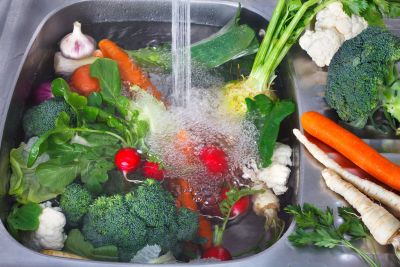Prior to Washing Fresh Garden Vegetables
A clean, sanitized prep area is the first step to reducing food borne disease or contaminants. Wash your hands (with soap, please!) prior to preparing produce. Clean cutting boards, utensils, sink and counter tops with hot soapy water before prepping fruits and vegetables. Clean between the peeling and cutting of different produce since the bacteria from the outside of say, a fresh picked cantaloupe, can be transferred to another item, like the newly harvested tomatoes you are cutting for a salad. If you aren’t using your own harvested produce, consider buying local from the farmers market, as long transport times from produce suppliers to grocery store encourage bacterial contamination and growth. Purchase only what you need and be sure that leafy greens and items like cut melons have been stored on ice. Alternate the variety of produce you eat, especially if you are purchasing food that you have not grown. This is nutritionally sensible, but also limits potential exposure to any one variety of pesticide or dangerous microbes. Once it’s home, wait to wash it until just before using. Prior washing and then storage promote bacterial growth and speed up spoilage. Before you store your produce, either purchased or dug out of the garden, remove the tops of veggies such as celery and the outer leaves of most greens, which have more dirt and pesticide residue than the interior leaves. Store any items in need of refrigeration, above raw meat, poultry and seafood in perforated bags to allow for air circulation.
How to Wash Vegetables and Produce
While washing garden vegetables will not completely remove or kill lurking microbes, it is an effective way to reduce their numbers. It will also remove any lingering dirt and the clinging slugs and spiders aforementioned. There is no need to use detergents or bleach when washing fresh vegetables or fruit; in fact, this can be dangerous, or at the very least it may make the produce taste quite nasty. While there are commercially available chemical washes for vegetables and fruit, the FDA has not evaluated their potential safety. Simply use plain old ordinary cold, tap water — no more than 10 degrees colder than the produce to prevent entry of microorganisms into the blossom or stem ends. Running water should be used in most cases. A scrub brush can be used on hard rind produce. If you need to soak produce, use a clean bowl rather than your possibly contaminated sink. You can add ½ cup (118 ml.) of distilled vinegar to each cup of water when immersing to reduce bacteria, followed by a good water rinse. This may affect the texture and taste though, so be forewarned. A slightly different method of cleaning harvested or purchased fruits and vegetables will be needed depending upon the produce, but here are some general guidelines:
Leafy greens, like lettuce, should be separated and the leaves individually rinsed, discarding damaged outer leaves. You may want to immerse particularly grubby leaves in water for a couple of minutes to loosen the dirt. Herbs can also be submerged in cool water. Then, blot dry with clean paper towels or use a salad spinner. Apples, cucumbers and other firmly fleshed produce should be washed well under running water and/or peeled to remove the wax preservative often found on store bought products. Scrub root veggies such as turnips, spuds and carrots under running water or peel them. Melons (as well as tomatoes) are highly susceptible to microorganism contamination, so scrub thoroughly and wash under running water before peeling the rind from the fruit and slicing into. Salmonella tends to grow on cut surfaces or in the stem, scars, cracks or other damaged areas. Cut these away before continuing to work with the melon and refrigerate any unused melon within two or three hours. Soft fruit such as plums, peaches, and apricots should be washed just before eating or prepping under running water and then dried with a clean paper towel. Other fruit such as grapes, berries and cherries should be stored unwashed until use and then washed gently under running cool water just before eating or prepping.
